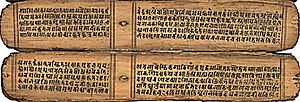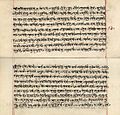Sanskrit facts for kids
Quick facts for kids Sanskrit |
||||
|---|---|---|---|---|
| संस्कृतम् saṃskṛtam | ||||

The word Sanskrit (संस्कृतम्) written in Devanagari.
|
||||
| Region | South Asia | |||
| Native speakers | 14,000 (2001) | |||
| Language family |
Indo Aryan
|
|||
| Writing system | No native script. Written in Devanagari, various Brāhmī-based. |
|||
| Official status | ||||
| Official language in | one of the 22 scheduled languages of India |
|||
|
|
||||
Sanskrit is an ancient Indian language. It is a sacred language of Hinduism, Buddhism and Jainism and the origin of most Indian languages. Today, about 14,000 people in India use it as their daily language. It is one of the 22 official languages of India and an official language of the state of Uttarakhand.
Sanskrit is a standardized dialect of Old Indo-Aryan. Its linguistic ancestry can be traced back to Proto-Indo-European. The Indo-Aryan migration theory proposes that the Indo-Aryans migrated from the Central Asian steppes into South Asia during the early part of the 2nd millennium BC, bringing with them the Indo-Aryan languages. The main script used to write Sanskrit is Devanāgarī, but it can be written in the scripts of various Indian languages and is sometimes written by the Latin alphabet.
[1]William Jones, working as a judge in India in the 18th century, studied Sanskrit and recognized similarities of Sanskrit with Latin and Greek.
Sanskrit literature includes poetry and drama. There is also scientific, technical, philosophical and religious texts. Sanskrit continues to be widely used as a ceremonial language in Hindu religious rituals and Buddhist practice in the form of hymns and chants.
The language has a very complex grammar, with eight grammatical cases, the grammatical genders, and three grammatical numbers.
Images for kids
-
Rigveda (padapatha) manuscript in Devanagari, early 19th century. The red horizontal and vertical lines mark low and high pitch changes for chanting.
-
The Spitzer Manuscript is dated to about the 2nd century CE (above: folio 383 fragment). Discovered in the Kizil Caves, near the northern branch of the Central Asian Silk Route in northwest China, it is the oldest Sanskrit philosophical manuscript known so far.
-
A 5th-century Sanskrit inscription discovered in Java, Indonesia—one of the earliest in southeast Asia after the Mulavarman inscription discovered in Kutai, eastern Borneo. The Ciaruteun inscription combines two writing scripts and compares the king to the Hindu god Vishnu. It provides a terminus ad quem to the presence of Hinduism in the Indonesian islands. The oldest southeast Asian Sanskrit inscription—called the Vo Canh inscription—so far discovered is near Nha Trang, Vietnam, and it is dated to the late 4th century to early 5th century CE.
-
One of the oldest surviving Sanskrit manuscript pages in Gupta script (c. 828 CE), discovered in Nepal
-
The ancient Yūpa inscription (one of the earliest and oldest Sanskrit texts written in ancient Indonesia) dating back to the 4th century CE written by Brahmins under the rule of King Mulavarman of the Kutai Martadipura Kingdom located in eastern Borneo
-
Sanskrit festival at Pramati Hillview Academy, Mysore, India
See also
 In Spanish: Sánscrito para niños
In Spanish: Sánscrito para niños











